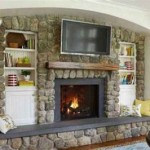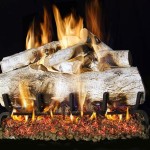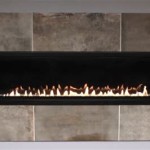Firebox for Fireplace Insert: A Comprehensive Guide
A fireplace insert is a self-contained heating appliance designed to be installed within an existing fireplace opening. It provides a more efficient and controlled heating solution compared to an open fireplace. A critical component of any fireplace insert is the firebox, the chamber where combustion occurs. The firebox's design, materials, and functionality significantly influence the insert's performance, efficiency, and longevity. This article provides a comprehensive overview of fireboxes for fireplace inserts, covering their construction, materials, key features, and factors that influence their performance.
Firebox Construction and Design
The firebox serves as the central location for burning fuel, whether wood, gas, or pellets, within a fireplace insert. Firebox construction typically involves a robust enclosure designed to contain high temperatures and direct the heat effectively. The design and shape of the firebox profoundly affect combustion efficiency, airflow, and heat distribution.
Frequently, fireboxes are rectangular or slightly tapered to optimize airflow and promote complete combustion of the fuel. Baffles, secondary air tubes, and other internal components are often incorporated into the firebox design to further enhance combustion efficiency and reduce emissions. These elements work by introducing preheated air at specific points within the firebox, allowing unburned gases to ignite and release more heat.
The size of the firebox is another critical factor. A larger firebox can accommodate more fuel, allowing for longer burn times. However, an excessively large firebox may lead to incomplete combustion if it's not properly matched to the insert's overall design and the heating needs of the space. Conversely, a small firebox might require more frequent refueling, potentially reducing convenience.
The firebox typically includes a door or viewing area constructed from high-temperature glass. This allows users to observe the fire and monitor combustion while maintaining a sealed environment. The door is crucial for controlling airflow and preventing smoke and fumes from escaping into the room.
Proper insulation is also an integral part of firebox construction. Insulation minimizes heat loss through the firebox walls, ensuring that more heat is radiated into the living space. This insulation can take the form of ceramic fiber blankets, firebrick, or other high-temperature resistant materials.
Materials Used in Firebox Construction
The materials used in firebox construction must withstand extremely high temperatures and prolonged exposure to the corrosive byproducts of combustion. Selection of appropriate materials is vital for the firebox’s structural integrity and overall lifespan of the fireplace insert.
Steel: Steel is a commonly used material, particularly for the outer shell of the firebox. Steel provides strength and durability. Thicker steel gauges tend to be more resistant to warping and cracking under extreme heat. Different types of steel are employed, including carbon steel and stainless steel. Stainless steel offers increased corrosion resistance, extending the lifespan of the firebox, particularly when burning fuels that produce corrosive compounds.
Cast Iron: Cast iron is another popular choice for firebox construction. Its excellent heat retention properties allow it to radiate heat evenly over a longer period. Cast iron is also known for its durability and resistance to warping. However, cast iron is more brittle than steel and can be susceptible to cracking under significant thermal stress. It is often used for components like grates and door frames.
Firebrick: Firebrick is a refractory material specifically designed to withstand direct exposure to flames and extreme temperatures. It is often used to line the interior of the firebox, protecting the steel or cast iron shell from intense heat. Firebrick helps to retain and radiate heat, improving the overall efficiency of the fireplace insert. It can be shaped into various forms to fit the contours of the firebox.
Ceramic Fiber: Ceramic fiber blankets or boards are used as insulation around the firebox. They provide excellent thermal resistance, minimizing heat loss and improving the insert’s efficiency. Ceramic fiber is lightweight and easy to install, making it a popular insulation choice.
The selection of materials often depends on the specific design and intended use of the fireplace insert. Manufacturers carefully consider factors like cost, durability, heat transfer properties, and resistance to corrosion when choosing materials for the firebox.
Key Features Affecting Firebox Performance
Several key features determine how efficiently and effectively a firebox functions. These features impact combustion efficiency, heat output, and the overall performance and user experience of the fireplace insert.
Airflow Design: The way air enters and circulates within the firebox significantly impacts combustion. Efficient fireboxes incorporate primary and secondary air inlets. Primary air supports the initial combustion of the fuel, while secondary air helps to burn off unburned gases, reducing emissions and increasing heat output. The placement and control of these air inlets are carefully engineered to optimize combustion efficiency.
Baffles and Secondary Combustion Systems: Baffles are strategically placed within the firebox to redirect hot gases and increase their residence time. This allows more complete combustion, reducing emissions and maximizing heat extraction. Secondary combustion systems introduce preheated air into the upper portion of the firebox, which further burns off unburned gases. These systems contribute to cleaner burning and higher efficiency.
Catalytic Combustors: Some fireplace inserts incorporate catalytic combustors, which are devices that further reduce emissions by oxidizing unburned gases at a lower temperature. Catalytic combustors consist of a ceramic substrate coated with a catalyst, typically platinum or palladium. These catalysts promote the oxidation of carbon monoxide, hydrocarbons, and other pollutants, resulting in cleaner exhaust. While catalytic combustors can significantly reduce emissions, they require regular maintenance and can degrade over time, reducing their effectiveness.
Glass Door Design: The design of the glass door affects not only aesthetics but also the firebox's performance. The glass must be capable of withstanding high temperatures without cracking or shattering. Airwash systems are often integrated into the door design to keep the glass clean, providing a clear view of the fire. These systems direct a stream of air across the inner surface of the glass, preventing soot and creosote from accumulating. The seal around the door is crucial for preventing air leaks, which can compromise combustion efficiency and lead to uncontrolled burning.
Fuel Type Compatibility: The firebox design must be tailored to the specific fuel type it's intended to burn, whether wood, gas, or pellets. Wood-burning fireboxes require adequate space and airflow for optimal combustion. Gas-burning fireboxes utilize burners and gas control systems designed for efficient and safe operation. Pellet-burning fireboxes incorporate augers and feed systems to deliver pellets to the combustion chamber. Different fuels have different combustion characteristics, and the firebox design must account for these variations.
Oxygen Depletion Sensor (ODS) (For Gas Inserts): For gas fireplace inserts, an ODS is a crucial safety feature. It continuously monitors the oxygen levels in the room and shuts off the gas supply if the oxygen level drops below a safe threshold. This prevents carbon monoxide poisoning in the event of incomplete combustion or poor ventilation.
Efficiency Ratings: Fireplace inserts are often rated for efficiency, typically expressed as a percentage. This rating indicates the proportion of fuel energy that is converted into usable heat. Higher efficiency ratings translate to lower fuel consumption and reduced heating costs. Factors such as firebox design, insulation, and combustion systems all contribute to the overall efficiency rating.
The firebox is a critical component of a fireplace insert, and its construction, materials, and design directly impact the insert's performance, efficiency, and longevity. Understanding these aspects can aid informed decisions when choosing a fireplace insert and ensure safe and efficient operation for years to come.

Procom Universal Ventless Firebox 170016 The Home Depot

Fireplace Insert Guide Fireplaces Direct Learning Center

Modern Flames Redstone 30 Inch Built In Electric Fireplace Insert Firebox Heater Rs 3021 Fireplaces Depot

Dimplex Revillusion 30 In Built Electric Firebox Insert Rbf30 The Home Depot

Pleasant Hearth Phzc42f 42 In Radiant Zero Clearance Universal Firebo

Dimplex 28 Multi Fire Xhd Plug In Electric Firebox Insert Logs Xhd28l Fireplaces Depot

Pleasant Hearth Universal Circulating Zero Clearance 36 In Ventless Dual Fuel Fireplace Insert Phzc36c The Home Depot

Inset Inbuilt Fireplace Buyer S Guide Regency

Fireboxes Gas Electric Buy Free

Modern Flames Redstone 42 Inch Built In Electric Fireplace Insert Firebox Heater Rs 4229 Fireplaces Depot
Related Posts








